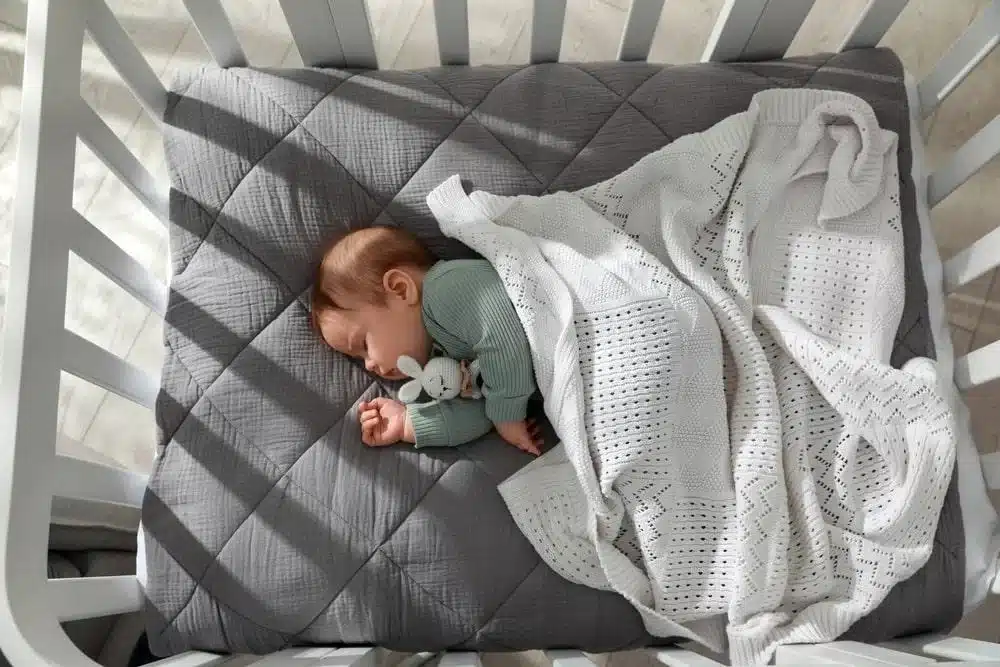Have you ever wondered how to make a baby crib more comfortable? As an expert in infant care, we understand the importance of a cozy and comfortable crib for your baby. The excitement of welcoming a new baby into your family should be as memorable as possible; however, ensuring that the baby gets quality sleep and rest in the crib is quite challenging. Not only will your child love resting in such an atmosphere, but this will also help you relax knowing that your baby is well-rested. This guide will provide practical and easy solutions on how to convert a simple crib into a comfortable heaven. Your baby’s sweet dreams await and we are here to guide you every step of the way so keep reading.
Why Do Babies Refuse to Sleep in Crib?
Sleeping is a journey full of wonder and challenges for a baby. Understanding why some babies may not like sleeping in cribs is a vital factor in understanding how to cater to the needs of both baby and parent.
1. The Novelty Factor:
Moving from the embracing arms of a caregiver or familiar cot to a crib can be very challenging for a baby. With its unfamiliar environment, the crib becomes an entirely new scene. This results in a natural resistance by the baby as the battle to adapt is fought.
2. Overtiredness and Difficulty Falling Asleep:
Similar to adults, babies can have overtiredness, which results in fussiness and difficulty falling asleep. Once transitioning to the crib becomes an integral part of a baby’s sleep, an overtired baby may have trouble sleeping, which could manifest in resistance.
3. Uncomfortable Crib Conditions:
That will depend on the comfort of the crib, which is so crucial. Unpleasant conditions like a misplaced mattress, rough sheets, and inappropriate room conditions may not be counted in considering the crib as a sleeping place.
4. Illness or Teething:
Many times, physical discomforts, such as illness or teething, cause babies to find very little comfort in their cribs. Cries are not uncommon, as babies are forced to spend time in the crib only to realize they are not as comfortable as other places in the house.
5. Fear of the Dark:
Babies feel frightened and uncertain about their unfamiliar surroundings and nights. As light is removed and strange bed objects go away from the crib, it can lead to an association between unease and an unwillingness to sleep for the night.
6. Premature Transition to a Crib:
Early introduction of the crib during a baby’s developmental stages could bring forth resistance. It is necessary to assess if the baby is prepared for cribbing at various stages of growth because different babies may not yet be “ready” for such a transition.
Also Read: Do baby crib mattresses expire? (And When to Replace It)
Ensuring Crib Safety:
Creating a safe sleep environment for your baby starts with the bed. The bed is the centre point from which other factors flow. Creating a safe crib requires an understanding of many features, including the construction of the crib and the mattress on which your small baby sleeps.
Things You Should Consider in Making a Crib Safe:
Making the crib the safest sleep haven for your baby starts with careful consideration of the components and the overall design of the crib. It also helps to avoid the risk of a baby’s head getting stuck between the slats, which could lead to the baby’s injury. Secondly, check the crib for any sharp pieces of equipment that can scrape or cut your baby’s skin.
Another significant factor is the inclusion of a reliable and adjustable mattress support system. This will, in turn, ensure that the mattress remains in place, thus avoiding any gap that may lead to an entrapment risk. Ensuring that there is no slack and an appropriate locking system for drop-side cribs are some measures to keep the crib’s structure steady.
Things You Should Consider in Making a Crib Mattress Safe:
1. Proper mattress size:
The size of the crib mattress is critical to creating a safe sleep environment. To avoid any entrapments, ensure that the bed fits tightly in the crib frame without any spaces. The right size of the mattress is necessary, such that it leaves a gap of only one or two fingers from its edges, to prevent accidents from occurring.
2. Optimal Firmness for Safety:
A crib mattress should be firm enough to support safe sleep for infants. Choosing the right firmness of a new mattress prevents the threat connected with SIDS. A baby’s developing skeleton is supported by a firm mattress, which minimizes any chances of suffocation or positional asphyxia.
When choosing a crib mattress, it is recommended that one go for infant-specific crib mattresses that meet safety standards. A reinforced edge mattress cover makes the mattress more waterproof and provides a higher safety rate and longer service life.
How to Make a Baby’s Crib More Comfortable?
Providing your child with a safe and comfy crib is an art that should be made from a mosaic of calm things to make sure it is not simply a secure place for sleeping but a relaxing spot for them.
1. Use Sleep Sacks or Swaddle Wraps:
Using an old technique such as swaddling or using sleep sacks may help make your baby feel safe. This soft, cocoon-like hug is not only supportive during sleep but also simulates warmth and comfort for added peace.
2. Introduce White Noise or Soothing Music:
The audible delights transform your baby’s crib into a blissful place. Soft backgrounds such as white noise and calming tunes help drown out the noise, allowing one to have a good sleep. Try out different soothing lullabies, nature songs, and white noise, and discover which is the most appealing for your baby.
3. Offer a Pacifier:
The smallest thing, such as giving a pacifier, can help your bato comfort themselves and calm down on their own. This repetitive suction, apart from being an effective comfort measure, has been proven to also lower the prevalence of SIDS and thus forms part of the overall bedtime routine that parents use in their baby’s crib.
4. Incorporate a Crib Mobile:
Enhance the appearance of your baby’s bed with the addition of an adorable crib mobile. Baby’s attention is attracted by these charming down-hung embellishments, which at the same time stimulate sensory receptors in development. Choose phones with soft, mild contrasts and gentle movement to create a fascinating, calm atmosphere to help your baby fall asleep.
5. Maintain the Appropriate Room Temperature:
Maintaining a proper balance on how warm your baby’s room should be will ensure their comfort. Make sure the room temperature is neither excessively warm nor cool, and consider the use of good and right bedding. A comfortable, cool, ventilated environment improves sleep quality for babies so that they do not get heated up.
6. Ensure Cleanliness and Minimize Clutter:
A calm sleep space should be created by having a tidy crib free of clutter. Check regularly for any lost items, and keep making sure that your baby’s crib is still a calm and comforting place. Clutter reduction is not only associated with eliminating possible irritants or nuisances but also leads to an orderly visual environment that serves as a serene background for a baby’s nap.
Also Read: Best 7 Ideas for Baby Crib Alternatives
What Else Can You Put in Your Baby’s Safe Crib?
There are certain considerations to make when selecting safe gadgets to include in the baby’s crib to ensure a snug and secure sleeping spot. Although safety regulations advocate simplicity, there are certain items that, if carefully chosen, may improve one’s baby’s crib experience without putting them at risk.
Blankets:
Adding lightweight and breathable blankets to your baby’s crib might be a comforting option. Go for light-weight materials that allow better air circulation and pick out proper, not-too-bulky blankets to save the baby’s life. Wrapping the edges of the blanket around the mattress and also keeping it above the baby’s chest gives warmth but no choking.
Crib Bumpers:
Cautious use of crib bumpers can act as barriers to avoiding limb entrapment. However, it is necessary to select breathable and thin bumpers that do not cause asphyxia. Bumpers should also be well secured to the sides of the crib with no loose ties and no gaps to make the area even safer for your baby.
Stuffed Toys:
Soft and small stuffed animals add a bit of a home-like touch to the crib. Select toys of the appropriate size with no small parts that can cause choking. This helps create a safe place for your child to rest with soft-stuffed animals to keep them company and ensures that the toys are removed well away from the sleeping area so as not to block the baby’s face during slumber.
Creating a Relaxing Bedtime Routine:
The development of an effective calming bedtime routine is paramount when it comes to ensuring peaceful and relaxing nights for your child.
1- Establishing a Consistent Sleep Schedule
A constant sleep schedule constitutes an important part of an effective bedtime routine. Repeatedly doing this gives your baby a sense of order, which will signal to the child that he or she should rest. Setting up a habit helps control the internal clock as they move towards sleep.
2- Dimming Lights and Creating a Calming Atmosphere
The dimming of lights as night falls is an increasingly essential element of most bedtime routines. It is quite purposeful that this transition in lighting works as a signal for your child that his or her sleep time is about to begin. Soft, warm lamination like a nightlight or muted lamps are some of the ways you can create a soothing environment that promotes relaxation and facilitates sleep.
3- Engaging in Soothing Pre-Sleep Activities:
Incorporating such pre-sleep calming activities helps build the bond with the bedtime routine, thereby adding more comfort to the entire process. A bonding experience with your infant is achieved through activities like reading a bedtime story, singing lullabies, and giving a gentle massage. They also signal your baby that it’s time for relaxation. These repetitive routine actions have a soothing effect on your kid before sleep time is due for him or her.
Also Read: Fun and easy ways to keep baby legs from getting stuck in crib
Conclusion:
Finally, trying to make the baby’s crib comfortable involves both rational factors and caregiving instincts. When we adopt this broad perspective, we are certain that the crib will be safe while turning it into a peaceful environment for our babies. The use of sleep sacks and white noise, among other elements, provides a sensory-rich environment for children’s restful sleep. Soft blankets, breathable bumpers, and cuddly stuffed animals enhance this feeling of warmth. Therefore, when incorporating these factors, let us be conscious of what they would prefer sleeping in since not all children will like the same arrangement. In this way, we make sure that the crib is not only comfortable from the material side but also emotionally and psychologically safe so that bedtime will be the favourite thing for both parent and child. A crib that is woven with care to create a haven with comfort and a personal touch to offer our dear babies a comfortable place for sweet dreams and peaceful nights.
Frequently Asked Questions:
Do babies sleep better on a softer mattress?
Babies generally sleep better on a mattress with the right balance of firmness. While it might be tempting to choose an ultra-soft mattress, experts recommend a firm surface for infants to reduce the risk of Sudden Infant Death Syndrome (SIDS). The firmness provides the necessary support for their developing bodies and ensures a safe sleep environment.
Why do babies sleep in the corner of the crib?
Babies often end up in the corners of their cribs due to their natural movements during sleep. As they start to roll and explore, they may unintentionally manoeuvre themselves into corners. To enhance crib safety, ensure there are no loose bedding or toys in the crib, and consider using sleep sacks to keep your baby comfortably contained without the risk of suffocation.
At what age can babies sleep on a softer mattress?
It’s crucial to maintain a firm mattress for infants up to at least the age of one. As your baby grows and becomes more mobile, usually around the toddler stage, you can gradually introduce a slightly softer mattress. However, always prioritize safety and consult with your paediatrician before making any changes to ensure they align with your child’s individual development.
How do I know if my crib mattress is too soft?
Determining if a crib mattress is too soft involves checking for proper support. Place your hand in the centre of the mattress and press down. If the mattress easily conforms to your hand and lacks resistance, it may be too soft. A mattress that maintains its shape and provides consistent support is generally a safer choice for your baby. Always follow the manufacturer’s guidelines and consult with your paediatrician for personalized advice.
Read more: 7 Excellent Reasons to Skip the Crib (With My Experience)








